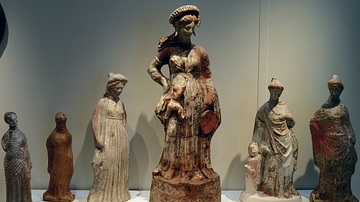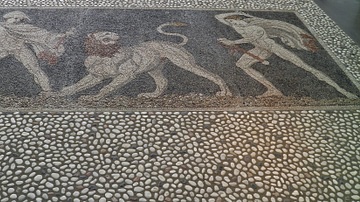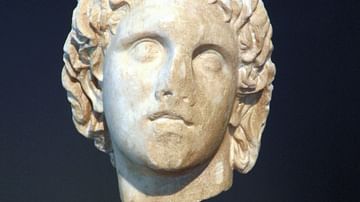Illustration
Terracotta bust of a Macedonian goddess or princess from Pella, found in the Agora, dating from the 4th century BCE.
Archaeological Museum of Pella.
In stark contrast to the limited view of women offered in ancient writings about Macedonia, the visual culture of the region gives us a manifold picture par excellence of female life in Classical, Hellenistic, and Roman times. Painted and sculpted heads, busts, and bodies retrieved from remains of interior and exterior spaces can give us a vivid, solid picture of women's likings, lifestyles, and common positioning, represented in their headwear, hairstyles, clothing (and nudity), as well as in their facial and bodily gestures and the objects they have with or around them.
The terracotta bust of a female in the Archaeological Museum of Pella is one of the many found in the ancient city of Pella, established in the early 4th century BCE by King Archelaus I of Macedon (r. 413-399 BCE) to replace the old capital city of Aigai. A prosperous port city at that time, Pella was the birthplace of Philip II of Macedon and his son, Alexander the Great. Accordingly, the population of the elite, from courtiers to traders to thinkers, must have been notably vast and varied, as reflected also in the size of the agora. The smiling young woman depicted here is perceived to be a goddess. Her sun-disk headwear with its long and bold tail is worn by many of her divine peers including Aphrodite and Demeter. It is likely to be a variation of the kausia, the Illyrian-Macedonian round hat of kings and commanders. Her short-sleeved peplos with a pronounced hem around the v-collar neck and her light-hearted, innocent face, however, might rather be symbolising the gentle and tranquil beauty idealised in depictions of princesses and other noble young women in Hellenistic art.
About the Author
External Links
Cite This Work
APA Style
Choubineh, N. (2024, October 09). Terracotta Bust of a Macedonian Goddess or Princess from Pella. World History Encyclopedia. Retrieved from https://www.worldhistory.org/image/19527/terracotta-bust-of-a-macedonian-goddess-or-princes/
Chicago Style
Choubineh, Nathalie. "Terracotta Bust of a Macedonian Goddess or Princess from Pella." World History Encyclopedia. Last modified October 09, 2024. https://www.worldhistory.org/image/19527/terracotta-bust-of-a-macedonian-goddess-or-princes/.
MLA Style
Choubineh, Nathalie. "Terracotta Bust of a Macedonian Goddess or Princess from Pella." World History Encyclopedia. World History Encyclopedia, 09 Oct 2024, https://www.worldhistory.org/image/19527/terracotta-bust-of-a-macedonian-goddess-or-princes/. Web. 03 Jul 2025.








